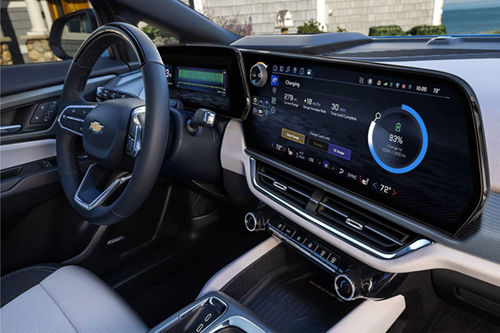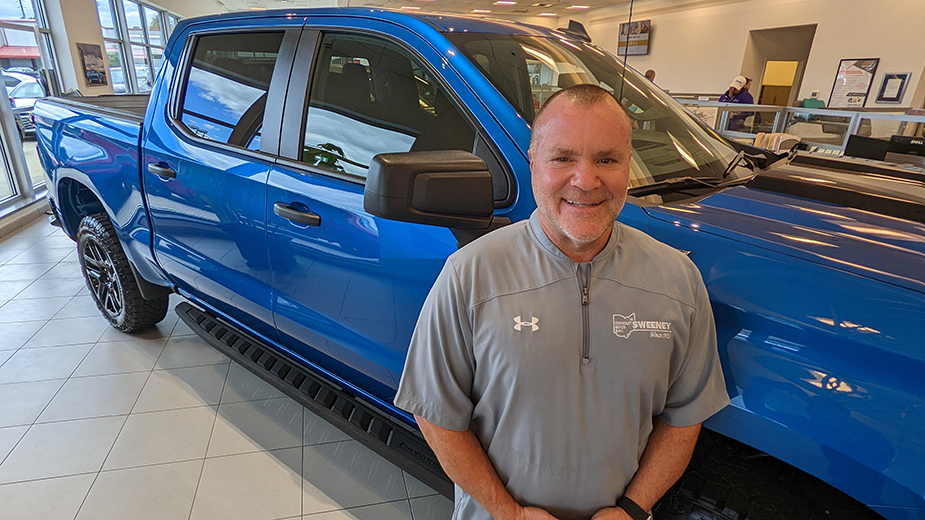BOARDMAN, Ohio – Bobby Stackhouse and other auto dealers left a meeting with Chevrolet executives in September feeling more optimistic than ever about the future of the iconic brand in electric vehicles.
“The numbers are eye-opening as to what they’re going to do production wise,” says Stackhouse, executive manager and partner at Sweeney Chevrolet in Boardman. “They have really big plans.”
Stackhouse can’t share additional details, he says, about EV production targets for Chevrolet – a nameplate that dates to 1911 and is synonymous with American car heritage. A television commercial during the mid-1970s seized on the theme – equating bucolic small-town life with “baseball, hot dogs, apple pie and Chevrolet.”
In that same spirit, Stackhouse says Chevrolet and General Motors Co. are aggressively moving in a direction that is transformational in terms of design, technology and customer support for its Chevy nameplate.
At the heart of the Chevrolet transition to EVs are three of its most popular vehicles: the Equinox, the Blazer and the Silverado pickup.
“I’ve seen the estimated production numbers for 2025,” Stackhouse says. “It’s huge numbers. They’re going headfirst into this. Eventually, we’re going to have lots full of EVs.”
All three EVs are set for launch next year, Stackhouse says. The Silverado is to begin commercial sales that spring, followed by the Blazer in the summer and the Equinox in the fall.
GM understands there are three major concerns consumers have relative to EVs, Stackhouse says.
The first is price. “I think they’ve tackled that with the Equinox.”

The initial retail price for the new Equinox EV compact SUV is approximately $30,000 – before any incentives – and not far from the $26,300 base price for a 2023 combustion engine model. “I think it shocked a lot of people because most people’s perception of EVs is that they might not be able to afford it,” Stackhouse says. “With a price point of $30,000, that takes away that fear.”
The Equinox is an important addition in that it enables younger buyers to consider an EV within their price range.
“With the flexibility of GM’s Ultium platform, we are bringing to market vehicles at nearly every price point and for every purpose,” GM Chairwoman and CEO Mary Barra said in September.
A second concern among potential EV buyers is battery range, Stackhouse says. GM, he relates, has taken measures to address this issue through technology and design.
Stackhouse says the Equinox has a range of about 300 miles on a single charge, while the Blazer is expected to have a capacity of 320 miles per charge. The Chevrolet Silverado, GM says, anticipates a range of 400 miles on a large battery pack. Moreover, GM has said that the EV pickup is able to add 100 miles of charge in just 10 minutes from a public DC Fast Charger.
“They are constantly trying to improve range,” Stackhouse says.
GM is also actively addressing a third question that consumers have raised, Stackhouse says: the issue of building enough infrastructure to satisfy what is already a growing demand for EVs.
As such, Chevrolet has launched an initiative called the Dealer Community Charging program. “GM realizes that EV infrastructure is lacking right now,” Stackhouse says. “They know that’s a huge concern for people.”
Under the program, Chevrolet will provide those dealerships that are signed on as EV retailers with up to 10 Level 2 chargers. The idea is to have the dealerships partner with businesses or organizations within their communities and install these chargers at various locations, Stackhouse says.
“That’s forward thinking that Chevrolet has,” he says. “There’s 3,000 Chevrolet dealerships in the country. When you multiply that by 10, that’s a good step in the right direction when it comes to infrastructure.”
Still, the Mahoning Valley lacks sufficient infrastructure to accommodate the projected volume of EVs. That, however, could change with programs such as the dealer community charging effort and public monies set aside in the federal Bipartisan Infrastructure Law to develop EV charging networks across the country.
“I think the infrastructure is going to be in a different spot than it’s in right now,” Stackhouse says.
Moreover, Chevrolet already has a leg up in the EV market, he says. In 2011, for example, the brand debuted its Chevrolet Volt, one of the first plug-in hybrid vehicles on the market. Commercial sales of the all-electric Chevrolet Bolt began in California in 2016; the vehicle was named Motor Trend Car of the Year in 2017.
In August 2021, GM initiated a recall of 141,000 Bolt EVs and the slightly larger EUVs because of a fire risk associated with its batteries. Production and retail sales of the vehicle were suspended but resumed in April 2002.
Since then, the Bolt EV and Bolt EUV have emerged as the comeback story of the year. Sales of the Bolt EV and EUV reached 14,709 units during the third quarter, outpacing supply and a record for a single quarter. In response, GM intends to increase production of both Bolt models for global markets – from 44,000 in 2022 to more than 70,000 in 2023.
A new pricing structure – the Bolt EV list price starts at $25,600 while the EUV begins at $27,200 – has helped to spur demand, the company said. So have incentives such as coverage for standard installation of home chargers for qualified buyers for a new Bolt.
“We don’t sell a lot of them,” Stackhouse says of the Bolt. “But from what we do have, we sell out very quickly.”
Early response to Chevrolet’s new EV lineup has been “tremendous,” says Chad Lyons, executive director, Chevrolet communications.
“Chevy is not new to selling EVs to our customers,” he says, referring to the Volt and Bolt. “In response to these new Ultium-powered EVs, we have seen tremendous interest.”
The Silverado EV, for example, has registered more than 170,000 reservations for the pickup, Lyons says. These reservations come from a mixture of retail customers and “intent from nearly 400 fleet operators,” he says.
Lyons says an EV-dedicated platform has freed up potential for Chevrolet’s engineers and designers. “It’s a blank-slate approach – not just more expressive designs, but also a flat-floor approach that allows for more interior space for customers,” he says.
Engineering and design improvements have also enabled technological features such as air-ride suspension and four-wheel steering in the Silverado EV. Super Cruise technology – which GM considers the first hands-free driving system for the freeway in the world – would be available in the Blazer and Equinox EVs.
Moreover, Lyons says that GM can move products from development to commercial production in half the time compared to previous development cycles. “GM is going through a measured transition to a new development process that relies more on virtual tools than on physical testing,” he says.
Prototypes of the Silverado and Blazer EVs have been manufactured, Lyons says, and an Equinox prototype should be ready soon.
GM’s use of its flexible Ultium platform allows it to offer vehicles in various segments while using the same battery chemistry and a series of electric motors, Lyons adds.
“Chevrolet is uniquely positioned in the industry with the recent introduction of three new EVs in the three largest and most competitive segments in the industry,” Lyons says. “These will be sold side-to-side with gas-powered counterparts – helping Chevrolet reach a wider swath of customers.”
One model slated for the near future is an EV version of the iconic Chevrolet Corvette, Stackhouse says. “It’s a Corvette E-Ray,” he says. “It’s going to blow people’s doors off.”
The newly enacted Inflation Recovery Act extends a $7,500 tax credit to those who buy a new EV manufactured in the United States.
“We’re excited about it,” Stackhouse says. “There are still more questions about the law. But I think it’s going to move the needle quite a bit.”
Once these models roll off the assembly line, Stackhouse says, consumers across the region will likely take to their enhanced features and technological capabilities.
“The technology is incredible. It’s all about technology at the end of the day,” the executive manager at Sweeney, says. “It’ll get people’s attention once they start driving them. You’re going to see them on the showrooms really soon.”
Editor’s Note: On the Road to EVs is sponsored by Sweeney Chevrolet, Buick, GMC.
Pictured at top: Bobby Stackhouse says Chevrolet’s electric vehicles will transform the brand.
